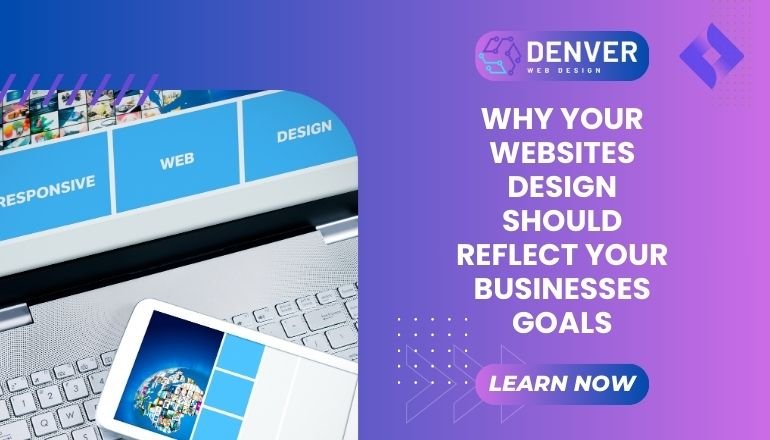
Your website serves as the digital face of your business, making its design a crucial factor in achieving your business objectives. A well-designed website goes beyond aesthetics, ensuring it aligns with your brand’s mission, vision, and goals. By focusing on best practices in web design and incorporating key elements like responsive web design and user experience, your website can become a powerful tool for growth.
Companies like Web Design Denver specialize in creating websites that bridge the gap between design and functionality, helping businesses thrive in a competitive digital landscape.
What Does It Mean for Your Website Design to Reflect Your Business Goals?
Simply put a website that reflects your business goals aligns every design and functionality decision with your organization’s objectives. Whether your goal is to increase sales, improve user engagement, or enhance brand awareness, your website must be built to serve that purpose.
For example, businesses aiming to grow e-commerce sales should prioritize features like intuitive navigation, secure payment gateways, and optimized product pages. Similarly, service-oriented companies need custom web design tailored to highlight their expertise and make it easy for visitors to connect.
Related concepts like the mobile-first approach and conversion rate optimization (CRO) ensure your website is user-friendly and designed to perform across various devices.
Why Aligning Website Design with Business Goals is Essential
Your website design is an extension of your brand. Consistent use of colors, fonts, and imagery conveys professionalism and helps build trust with your audience. A website that reflects your brand values will leave a lasting impression and set your business apart from competitors.
When your website is designed with clear goals in mind, it creates a smoother journey for users. Whether it’s quick navigation to product pages or seamless checkout processes, aligning design with goals ensures visitors can easily achieve what they came for. Leveraging UX design principles makes your website more intuitive and engaging.
- Boosts SEO and Online Visibility
A goal-driven website is built with SEO best practices in mind. Optimized layouts, fast load times, and mobile compatibility contribute to better search engine rankings. With improved visibility, your site can attract more traffic, increasing the chances of achieving your goals, whether they involve lead generation or sales.
- Increases Conversions
When design and goals align, the path to conversion becomes clear. For instance, strategically placed CTAs guide users to take specific actions, like signing up for newsletters or making purchases. Optimizing your website for conversions is a key factor in turning visitors into customers.
Key Features of a Goal-Oriented Website Design
- Mobile-First Design: Ensure your website is optimized for mobile users, as the majority of traffic now comes from smartphones and tablets.
- Clear CTAs: Use concise and compelling calls-to-action to guide visitors toward desired outcomes.
- Content Management System (CMS): A CMS like WordPress allows easy updates to align with evolving goals.
- SEO-Optimized Structure: Use proper headings, metadata, and keywords to improve search engine visibility.
- Analytics Integration: Tools like Google Analytics help track performance and assess how well your design supports your goals.
Best Practices for Aligning Website Design with Business Goals
- Define Clear Objectives: Before designing your website, identify your primary goals. This could range from increasing sales to building a subscriber base.
- Know Your Audience: Design with your target audience in mind. Understand their needs, preferences, and pain points to deliver a tailored experience.
- Prioritize Speed and Performance: Use techniques like image compression and efficient coding to ensure fast load times.
- Test and Refine: Regularly test your website’s performance, navigation, and content to ensure they align with your goals.
Common Mistakes to Avoid
- Focusing Only on Aesthetics: While a visually appealing website is important, neglecting functionality can hurt your business. A balance between form and function is essential.
- Ignoring Mobile Optimization: Without a responsive web design, you risk alienating mobile users and missing out on a significant portion of potential traffic.
- Overcomplicating Navigation: Complicated menus or hidden features can frustrate users and lead to high bounce rates.
- Skipping Regular Updates: A static website can quickly become outdated. Regular updates ensure your site stays aligned with your goals.
Conclusion: Key Takeaways
Your website design plays a pivotal role in reflecting and achieving your business goals. By focusing on custom web design, responsive web design, and user-friendly navigation, you create a platform that serves both your users and your objectives.
For businesses looking to create or optimize their websites, Web Design Denver offers professional web development services tailored to your needs. Start aligning your website design with your business goals today to boost user engagement, drive conversions, and achieve measurable success.






